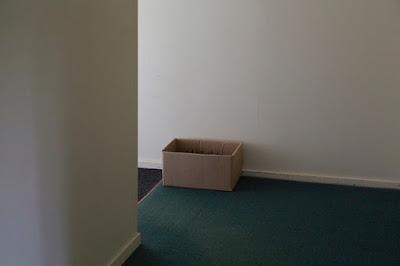25 April - 28 June, 2015
By Georgina Keyse
Richard Frater’s exhibition Living Cities 2011 at the Adam Art Gallery explored Frater’s experiences of Wellington city as an industrial site, as well as the nature of birdlife spreading from Zealandia to the city. The exhibition took place across two sites; an installation in the Kirk Gallery of the Adam, and an installation in a university flat. Art is superimposed on a setting that is for most an artless realm, a place where they perform the mundane tasks of living; eating, sleeping, watching TV. The spectator can view the city at the same time as they view the art, the two temporalities exist together, feeding meaning to one another. The exhibition asks; are art and life separate entities? Where do they intersect? How do we experience the city, and how do these experiences shape the way we interact with the work?
In the Kirk Gallery Frater performed an architectural modification by uncovering a window in the otherwise unlit room. The window, which overlooked the city, highlighted the objects in the room. A lead lined pestle and mortar were placed on the windowsill, and a nail gun was mounted on a pedestal in the corner of the room. This scene replicated a cinematic experience for the viewer. The room is often used by the gallery as a cinema, hence the total darkness without the addition of the window. The window acted in the same way as a projector, illuminating the objects on display. The addition of the window also had consequences for the meaning of the space as a gallery. It opened up the gallery to the outside world, allowing elements from each space to enter the other. It provided a form of mediation between the viewer, the art, and the city.
The installation continued in a university house, a space used for student accommodation. Inside the flat we were met by the audio component of the exhibition, a soundtrack created by Frater and sound artist Richard Francis, interspersed with birdsong. Another nail gun is mounted in the centre of a room, accompanied by a view of Wellington. Further into the house a box of lead roofing nails rests beside the entrance to one of the rooms. The impact of the industrial soundtrack is compounded by the presence of these building materials. Lead nails were used in much of the roofing during the housing boom in Wellington, and have an adverse effect on native birdlife for whom it is poisonous. Zealandia’s roaming representative, the kaka, ingest these toxins, returning to excrete them into the sanctuary.
Between these two spaces the viewer experiences several filmic qualities; the projected light and soundtrack, as well as the narrative of the walk to the second site. Our position as active participants in the installation mirrors the role of an actor. Frater is encouraging the participant to play this role and form our own experiences of the city. He explains, “The chronology of a walk can generate and perform a map of Wellington, triggering a range of casual and orchestrated experiences.”[1] In Living Cities 2011 Frater investigated the experience of industrial Wellington, the housing boom allowed by technological innovations such as the nail gun and the coinciding experience of kaka living in the city. He investigates how these two facets of the city interact, impacting on one another and the landscape they exist in.
Contemporary art practice has been interpreted as emerging as a response to a “multiplicity of relationships between being and time.”[2] Frater’s work shows similar concerns with the relationships between us, and our experience of place and time. Of Wellington he says, “It’s tempting to privilege one experience of the city over another as being less superficial, but the city was and is all of these multiple temporalities simultaneously.”[3] The use of gallery and non-gallery sites introduces a dialogue between art and life. The addition of the window into the Kirk Gallery allows the outside world to enter into the pristine gallery space. As a viewer our experiences are invited to play a part in understanding the work; our interaction with the city and the exhibition are all part of the story.
[1] Richard Frater, Laura Preston, catalogue for ‘Living Cities 2011 –‘, Wellington: Adam Art Gallery Te Pataka Toi, 2015
[2] Terry Smith, What is contemporary art?, Chicago: The University of Chicago Press, 2009, p. 4
[3] Richard Frater, Laura Preston, catalogue for ‘Living Cities 2011 –‘, Wellington: Adam Art Gallery Te Pataka Toi, 2015
Image 1. Richard Frater, Living Cities 2011–, 2015, installation view at the Adam Art Gallery, Victoria University of Wellington (photo: Shaun Waugh)
Image 2. Richard Frater, Living Cities 2011–, 2015, installation view at the Adam Art Gallery, Victoria University of Wellington (photo: Shaun Waugh)
Image 3. Richard Frater, Living Cities 2011–, 2015, installation view at the Adam Art Gallery, Victoria University of Wellington (photo: Shaun Waugh)



No comments:
Post a Comment